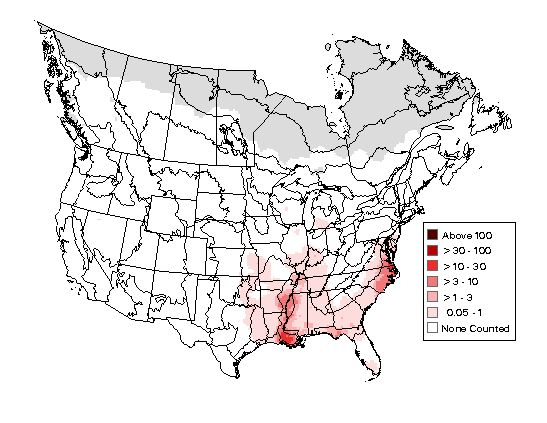Birdfinding.info ⇒ Fairly common but local and thinly distributed across much of its range, yet its conspicuousness and propensity for mature, swampy woodlands with little undergrowth often make it easy to locate during spring and summer in the eastern U.S. (see Breeding Bird Survey Abundance Map in Notes, below). Tends to forage at low levels, often near the waterline or just above the forest floor.
Prothonotary Warbler
Protonotaria citrea
Breeds in the eastern U.S. and southernmost Canada. Winters in Middle America and northern South America.
Breeding. Swamps and bottomland or riparian forests with dead or dying trees suitable for the excavation of nest cavities, from the southern Great Lakes region (north to southern Minnesota and southern Ontario) and the Mid-Atlantic (north to New Jersey and sparingly to Rhode Island) south to southern Florida. Highest concentrations are in the Mississippi Valley and the coastal plains of the Gulf of Mexico and Mid-Atlantic.
Nonbreeding. Winters mainly in swampy woodlands, especially mangroves, and in smaller number in other types of woodlands and scrub, from the Yucatán Peninsula to western Colombia and northwestern Venezuela.
Also uncommon or sporadic throughout the West Indies and in coastal lowlands east to the Guianas, with stragglers scattered over a wider area: west to California, north along the Gulf of Mexico, and south to Ecuador and northern Brazil.
Movements. Most migration is across the Gulf of Mexico. Migrates early in both directions, with arrivals on the breeding grounds beginning around mid-March and departures beginning in early August.
Spring overshoots are frequently found north of breeding areas, sometimes repeating at multiple years in the same location—which may be due to either the site fidelity of individuals or the quality of habitat at a particular site.
Fall vagrants appear throughout the western U.S., southern Canada, Mexico, the Caribbean, and (sometimes in surprisingly high numbers) on Bermuda.
Identification
A bright yellow warbler with a prominent, coal-black eye, long and heavy bill, greenish back, and blue-gray wings. Notably robust for a wood warbler, often appearing plump, big-headed, and short-tailed.
All of its plumages share the same general pattern and coloration, with small variations. The most consistent difference is that the bill is black in the breeding season and pale in winter.
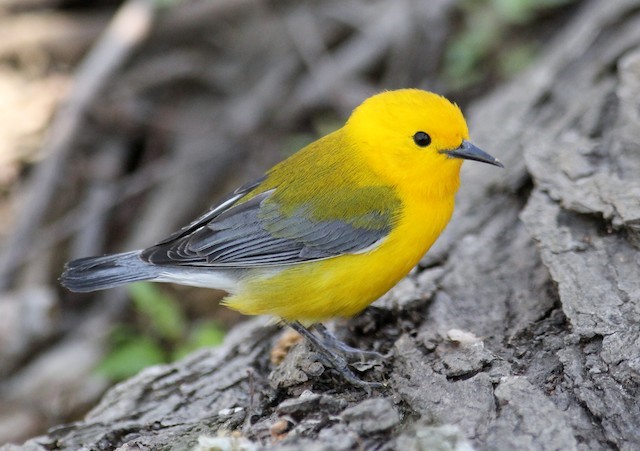
Prothonotary Warbler, male in breeding plumage. (Leonabelle Turnbull Birding Center, Port Aransas, Texas; April 15, 2018.) © Jason Leifester
Breeding adults, especially males, are striking and unmistakable due to their vivid golden-yellow plumage and boldly contrasting black eye and bill.
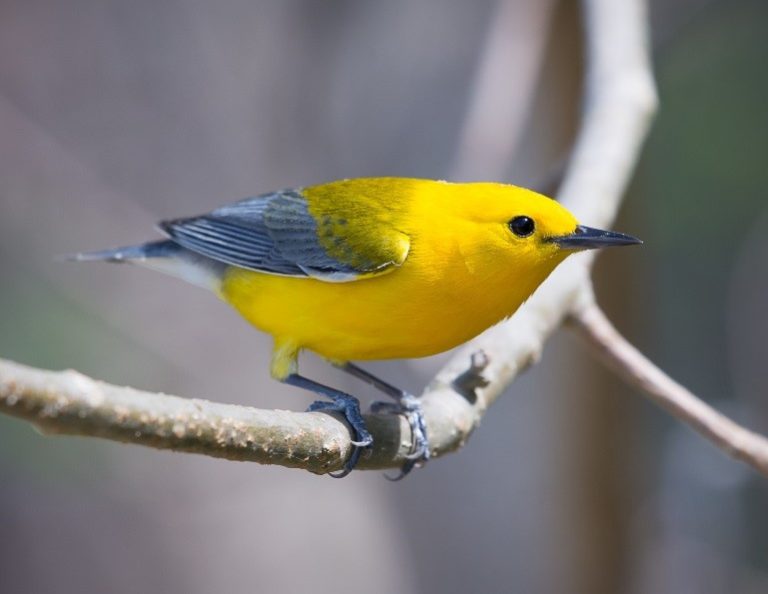
Prothonotary Warbler, male in breeding plumage. (Union County, Illinois; April 15, 2017.) © J. Satler

Prothonotary Warbler, male in breeding plumage. (Lettuce Lake County Park, Tampa, Florida; May 22, 2018.) © Peter Brannon

Prothonotary Warbler, male in breeding plumage. (Green Island Wildlife Management Area, Iowa; June 17, 2017.) © Tony Moline
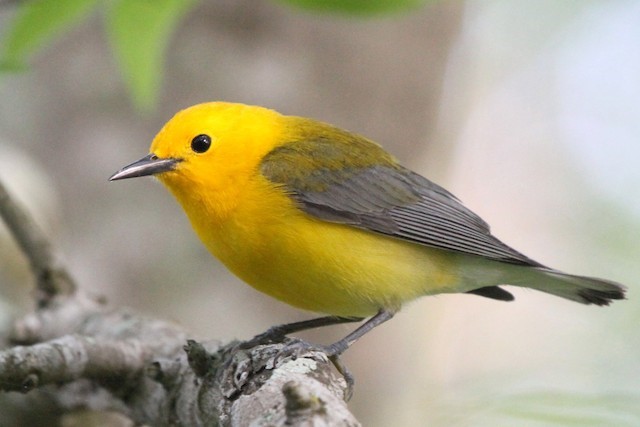
Prothonotary Warbler, male in breeding plumage. (Houston, Texas; April 7, 2013.) © Stephen Gast
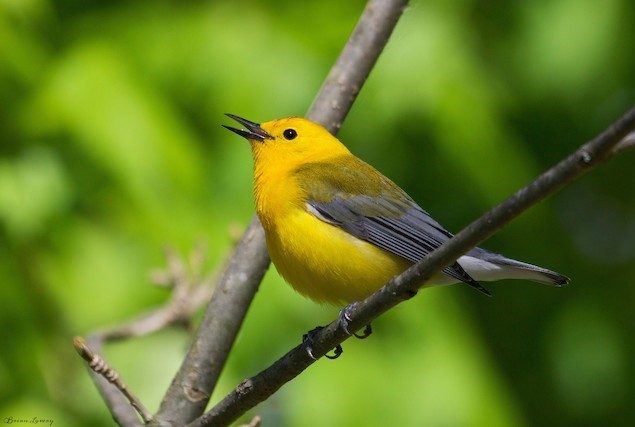
Prothonotary Warbler, male in breeding plumage, singing. (Little York, Indiana; April 23, 2017.) © Brian Lowry

Prothonotary Warbler, male with bill darkening into breeding color. (Isla de Salamanca, Magdalena, Colombia; February 13, 2016.) © Steven Whitebread
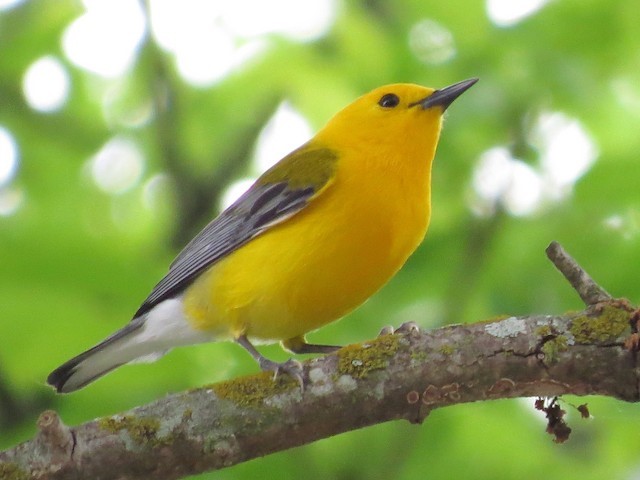
Prothonotary Warbler, male in breeding plumage—note pure-white vent and undertail coverts. (Granger Lake, Texas; April 15, 2017.) © Timothy Fennell
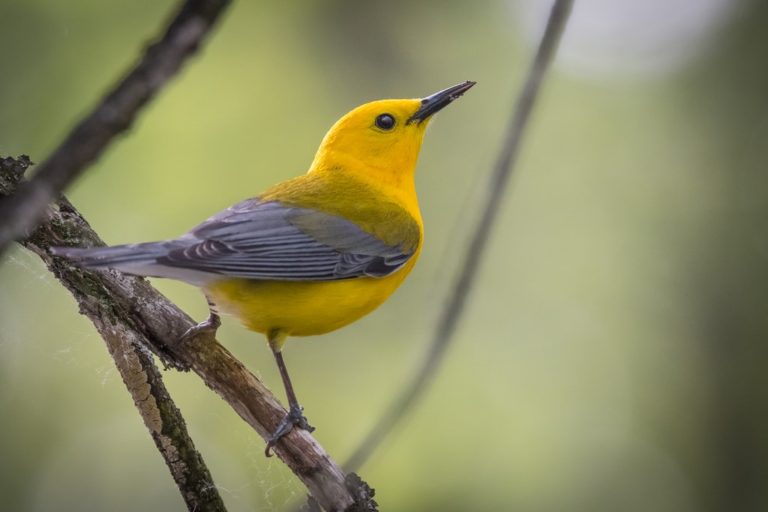
Prothonotary Warbler, male in breeding plumage. (Muskegon River State Game Area, Michigan; June 12, 2018.) © Aaron Kortenhoven

Prothonotary Warbler, male in breeding plumage. (Cedar River Crossing, Johnson County, Iowa; July 1, 2018.) © Mark Brown
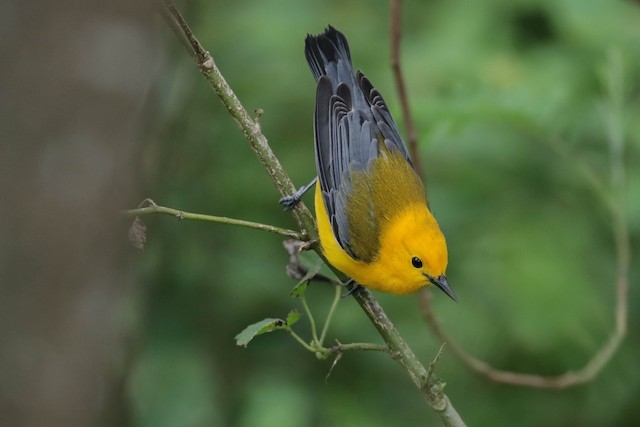
Prothonotary Warbler, male in breeding plumage—note contrasting black highlights in wings and tail. (South Padre Island, Texas; March 18, 2019.) © Peggy Rudman
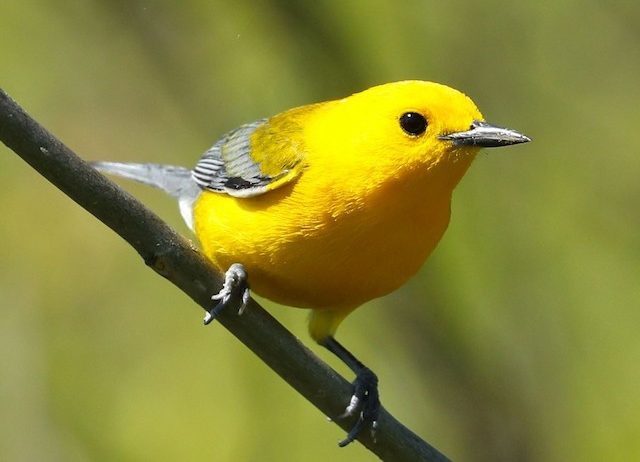
Prothonotary Warbler, male in breeding plumage, glowing in bright sunlight. (Red Slough Wildlife Management Area, Oklahoma; April 7, 2017.) © Charles Lyon
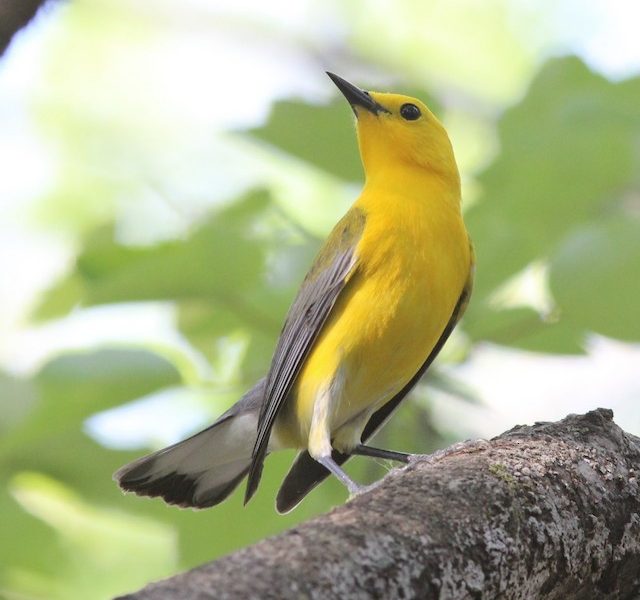
Prothonotary Warbler, adult in breeding plumage. (Cap Tram Road, Chaires, Florida; April 19, 2017.) © Daphne Asbell
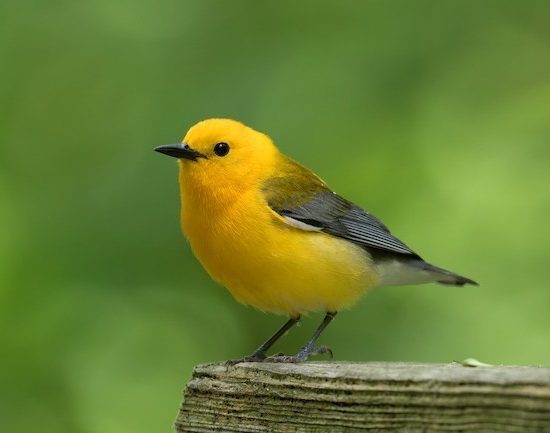
Prothonotary Warbler, male in breeding plumage (Susquehanna State Park, Maryland; June 7, 2017.) © Mark R. Johnson

Prothonotary Warbler, male in breeding plumage showing its affinity for the waterline. (Virginia Beach, Virginia; April 14, 2018.) © Mary Catherine Miguez

Prothonotary Warbler, male in breeding plumage, glowing in bright sunlight. (Hok-Si-La Park, Lake City, Minnesota; May 9, 2015.) © Taylor Long

Prothonotary Warbler, male in breeding plumage. (Red Slough Wildlife Management Area, Oklahoma; April 7, 2017.) © Charles Lyon
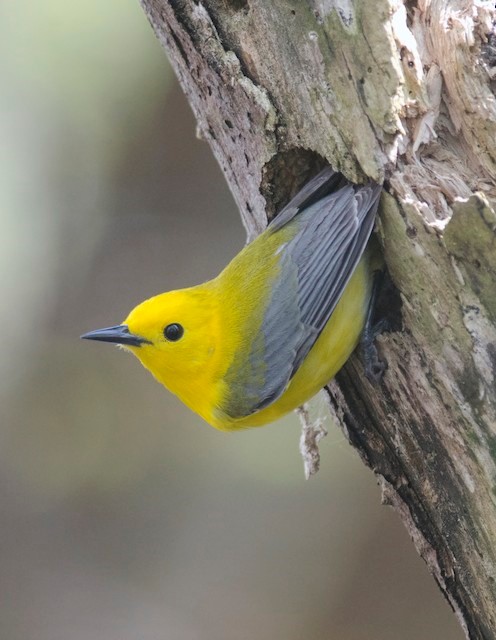
Prothonotary Warbler, adult (likely female) in breeding plumage. (Point Pelee National Park, Ontario; May 13, 2017.) © Joshua D. Vandermeulen
Non-breeding birds differ mainly in having pale bills, but this detail makes them less immediately recognizable in some circumstances. Confusion is possible with Blue-winged and female Yellow, Mangrove, and Hooded Warblers.

Prothonotary Warbler, female in non-breeding plumage. (Bubali Bird Sanctuary, Aruba; December 19, 2018.) © Michiel Oversteegen
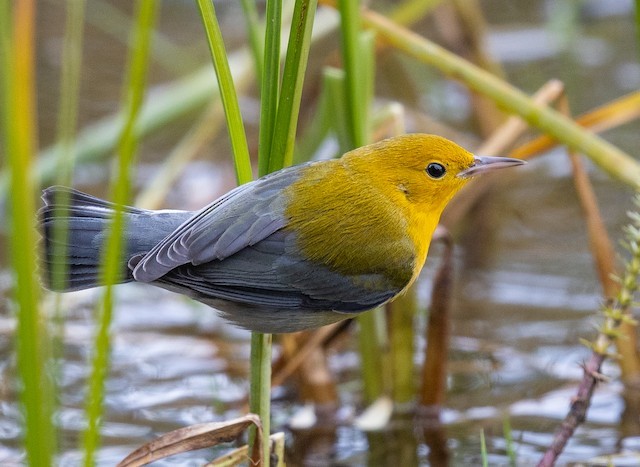
Prothonotary Warbler, likely immature. (Banff National Park, Alberta; September 18, 2018.) © Caroline Lambert
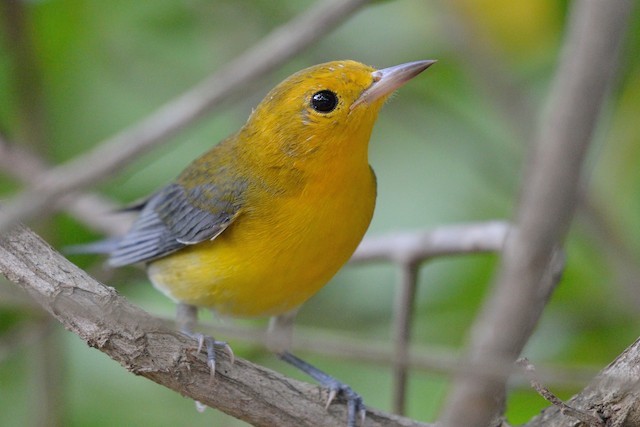
Prothonotary Warbler, female in non-breeding plumage. (Bubali Bird Sanctuary, Aruba; October 22, 2016.) © Steven Mlodinow
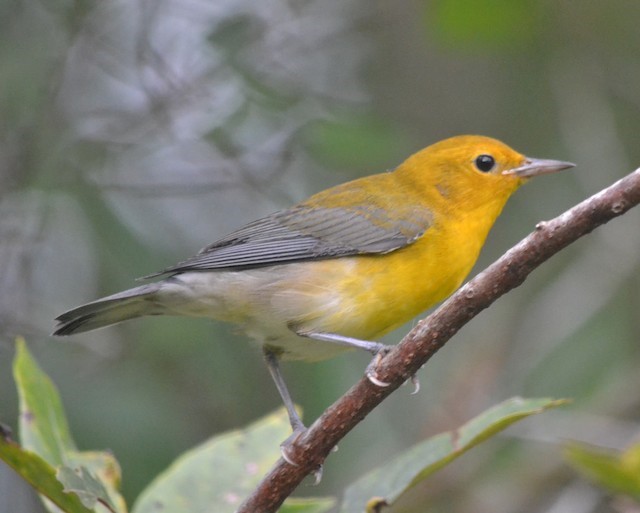
Prothonotary Warbler, immature. (North Topsail Beach, North Carolina; August 16, 2014.) © Andrew Rapp
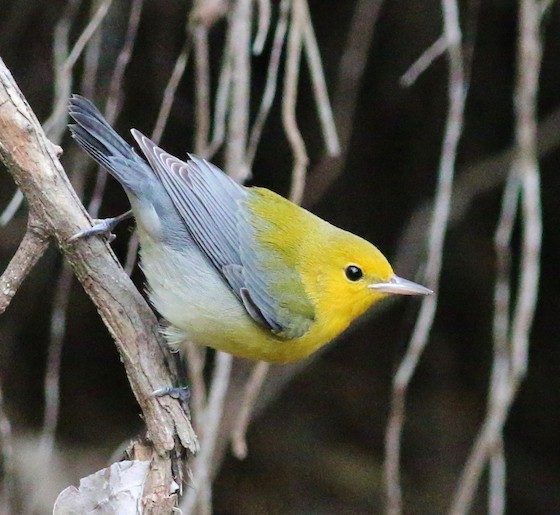
Prothonotary Warbler, immature. (Goleta, California; October 25, 2015.) © Tom Benson

Prothonotary Warbler, adult with bill fading out of breeding color. (Lettuce Lake County Park, Tampa, Florida; July 17, 2018.) © Peter Brannon

Prothonotary Warbler, female in breeding plumage—note darker-than-average crown. (Point Pelee National Park, Ontario; May 11, 2017.) © James Thompson

Prothonotary Warbler, male in non-breeding plumage. (Lettuce Lake County Park, Tampa, Florida; September 14, 2016.) © Peter Brannon

Prothonotary Warbler, male in non-breeding plumage. (Bubali Bird Sanctuary, Aruba; February 3, 2014.) © Steven Mlodinow

Prothonotary Warbler, adult in non-breeding plumage. (Shepherds Marsh, La Crescent, Minnesota; August 26, 2018.) © Todd Mitchell
Voice. Song is a loud and simple series of five or more evenly spaced, upslurred notes, sweet! sweet! sweet! sweet! sweet! sweet!
Notes
Monotypic species.
References
Alderfer, J., and J.L. Dunn. 2014. National Geographic Complete Birds of North America (Second Edition). National Geographic Society, Washington, D.C.
Ascanio, D., G.A. Rodriguez, and R. Restall. 2017. Birds of Venezuela. Christopher Helm, London.
Dunn, J.L., and K.L. Garrett. 1997. A Field Guide to Warblers of North America. Houghton Mifflin, Boston.
eBird. 2019. eBird: An online database of bird distribution and abundance. Cornell Lab of Ornithology, Ithaca, N.Y. http://www.ebird.org. (Accessed March 28, 2019.)
Fagan, J., and O. Komar. 2016. Peterson Field Guide to the Birds of Northern Central America. Houghton Mifflin Harcourt, New York.
ffrench, R. 2012. A Guide to the Birds of Trinidad & Tobago (Third Edition). Cornell University Press, Ithaca, N.Y.
Garrido, O.H, and A. Kirkconnell. 2000. Field Guide to the Birds of Cuba. Cornell University Press, Ithaca, N.Y.
Garrigues, R., and R. Dean. 2014. The Birds of Costa Rica: A Field Guide (Second Edition). Cornell University Press, Ithaca, N.Y.
Haynes-Sutton, A., A. Downer, R. Sutton, and Y.-J. Rey-Millet. 2009. A Photographic Guide to the Birds of Jamaica. Princeton University Press, Princeton, N.J.
Howell, S.N.G., and S. Webb. 1995. A Guide to the Birds of Mexico and Northern Central America. Oxford University Press, Oxford.
Latta, S., C. Rimmer, A. Keith, J. Wiley, H. Raffaele, K. McFarland, and E. Fernandez. 2006. Birds of the Dominican Republic and Haiti. Princeton University Press, Princeton, N.J.
McMullan, M., and T. Donegan. 2014, Field Guide to the Birds of Colombia (Second Edition). Fundación Proaves de Colombia, Bogotá.
Raffaele, H. 1989. A Guide to the Birds of Puerto Rico and the Virgin Islands. Princeton University Press, Princeton, N.J.
Raffaele, H., J. Wiley, O. Garrido, A. Keith, and J. Raffaele. 1998. A Guide to the Birds of the West Indies. Princeton University Press, Princeton, N.J.
Ridgely, R.S., and J.A. Gwynne. 1989. A Guide to the Birds of Panama (Second Edition). Princeton University Press, Princeton, N.J.
Ridgely, R.S., and G. Tudor. 2009. Field Guide to the Songbirds of South America: The Passerines. University of Texas Press, Austin.
Wells, J.V., and A.C. Wells. 2017. Birds of Aruba, Bonaire, and Curaçao. Cornell University Press, Ithaca, N.Y.


